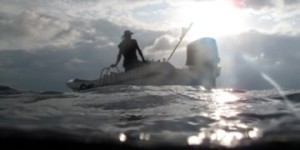IT WAS AN UGLY SHIP, AND STILL IS. The steamer Mohawk was a 387-foot workhorse on the weekly run to Havana, carrying freight and discount passengers in both directions. When it sailed out of New York for the last time, on January 24, 1935, the Mohawk had neither fame nor beauty, and it has taken a damn serious beating since then.
The first blow was administered by the Norwegian freighter Talisman, which slammed into the ship a few hours from Manhattan, slicing a deep gash in the bow. It took 70 minutes for the Mohawk to sink, enough time for most of the lifeboats to get away with most of the 164 people aboard, though not all. Forty-five lives ended on that icy night off the coast of New Jersey, and the Mohawk plunged 80 feet and cracked open on the sea floor. For most of the world, the story ended then and there.
But the awkward little ship never had a final resting place, nor any peace. Sitting upright on the silty bottom, the wreck’s tallest parts—the bridge and smokestack—were still hazards in the busy New Jersey shipping channels. Soon two tugboats were dispatched to wire-drag the wreck, forcing a heavy steel cable back and forth through the superstructure, snapping the deck plates apart, ripping the bridge from the hull, and scattering debris into the currents. A few years later, in World War II, the Coast Guard pummeled the Mohawk with depth charges; German U-boats had been hiding alongside wrecks in these waters, dodging sonar behind their bulky silhouettes.
With insult heaped on injury, the Mohawk was left to the mercy of the Atlantic. Decade by decade, the ocean shoved, pulled, twisted, flipped, and buried the ruins of the old boat and its rusting cargo of car parts and china. When scuba diving became a mass sport in the 1960s, a few visitors dropped onto the wreckage, but by the 1990s, as technology—advanced GPS, inexpensive side-scan sonar, and nitrox gas mixtures—made it easier to explore wrecks, a new wave of divers began to pick its bones. Hundreds of thousands of certified divers live along the Middle Atlantic seaboard, and nowadays a dozen or more of them can be found crawling over the vessel on any given summer Sunday.
Inevitably, those divers come back up with something: some trophy, some artifact, some souvenir. If they are lucky, or determined, they might find a porthole, bring it up, clean it, and slap it on the mantelpiece. Weekend by weekend, storm by storm, man and the elements are reducing the Mohawk to a memory. This would not concern me in the least, except that my uncle died on the S.S. Mohawk.
HE WAS MY FATHER’S eldest brother, William D. Symmes, a student at Williams College traveling with his geology professor and five classmates. They were scheduled to catch a plane from Havana to the Yucatán for an inspection of Mayan ruins. In the small world of families and acquaintances, January 24, 1935, was a black tragedy. A Massachusetts newspaper headlined a group photo of the six Williams passengers, taken right before they sailed: “JUST THREE RETURN ALIVE.”
Time dissolves grief, just as rust undoes the strongest steel, and while the Mohawk slowly broke apart on the ocean floor, a few pieces of its history began to surface again. A chunk of that forgotten past fell into my hands last summer—and then dropped hard onto my big toe, before skittering across the floor and lodging under a sofa. The item in question was a modest ceramic tile, thick, hexagonal, sharp-edged, about the size of an Oreo, that fell unexpectedly from an envelope stuffed with documents about the Mohawk. I’d requested the paperwork from Steve Nagiewicz, executive director of the Explorers Club in New York, a group as famous for its annual dinner (where else can you dine on tarantula tempura with astronauts?) as for the grand scientific expeditions of its members. But Nagiewicz’s interest in the Mohawk was personal, too—it lies just offshore from his New Jersey home. He runs a weekend dive-charter business, and like most Jersey divers, he knows the wreck well. Over the years he’s brought up plates and a few tiles, and it was one of the latter that he slipped into the envelope. Recovering the cream-colored tablet from under the couch, I steeled myself for any number of reactions: sorrow at encountering this touchstone from a tragedy, perhaps anger that this fragment had been rousted from a grave.
I wouldn’t have been the first to be outraged at the desecration of a lost ship. Ever since the early 1960s, when wildcat treasure hunters like the late Mel Fisher first pulled gold off Spanish galleons in the Florida Keys and marine archaeologists like George Bass of Texas A&M first sent frogmen down to Byzantine merchant ships in the Mediterranean, the rivalry between scholars and salvagers has deepened. Commercial salvagers, gold seekers, and souvenir hunters argue that they are rescuing value from the encroaching sea, that anything not removed will eventually be lost for good. Archaeologists counter that salvagers are disturbing vital cultural resources, like pot thieves defiling Anasazi ruins. Governments claim sunken warships as their patrimony. Insurance companies claim a share of lost treasure. Family members claim that wrecks should be left as undisturbed graves. The result has never been as simple as “finders-keepers,” nor as absolute as the legal rulings of dry-footed legislators. But as wreck diving increases, the calls for regulation grow louder: California allows only permitted archaeologists to remove objects from the 1,600 wrecks in its waters, and Wisconsin arrested a diver in 1998 for taking a porthole. In Britain, a group called Wreck Respect is agitating to ban all souvenir diving, everywhere. Last July, Paris-based UNESCO—the United Nations Educational, Scientific, and Cultural Organization—promulgated a new international convention defining any shipwreck older than 100 years as a “cultural deposit” and the “patrimony of mankind,” subject to restrictions including a total ban on amateur salvage. Lacking any enforcement mechanism, the new policy is toothless. Most wrecks lie in the shallow waters claimed by sovereign nations, and most maritime powers, including the United States, have refused to sign, claiming the convention contradicts existing laws of the sea.
Emotions are another matter. Turning the tile over in my fingers, I felt vaguely disappointed: It was cold, lifeless, a little bit ugly. The humble reality was that it probably came from the wall of a washroom or the floor of the galley. It wasn’t the time capsule I’d hoped for, and it carried no messages from the past. Within days I had called Nagiewicz and arranged for a deeper immersion.
“ABOUT NINE TWENTY, as though from some unknown danger, the room we were in fell into a deadly silence—no word was uttered. Then came the crash.” The final moments of the Mohawk were chaotic, according to one of the surviving Williams students. In a 28-page testimonial composed for the college archives, Karl Osterhout described the departure that blustery afternoon from Pier 13 in Manhattan and the crash just hours later. The Mohawk sailed the day after what the New York Daily News called the “worst storm since 1920”; 17 inches of snow had fallen on the city, and ice still coated the ship’s railings. As the vessel rounded Sandy Hook and headed south, the college students had no inkling that the steering system was freezing up. They ate dinner and then sat in the lounge, playing cards. Osterhout had just dealt a hand to my uncle when they heard a ship’s whistle blow, and then silence fell over the passengers. The Mohawk had veered out of its sea lane; everyone seemed to sense some danger approaching. It was the Talisman, which surged out of the night and into the Mohawk’s port bow.
“It didn’t seem like a big crash,” Osterhout wrote, “but there was a sound like splintering wood. At the impact everyone stood up simultaneously. One woman screamed.” The Talisman sheared off, drifting but intact, and after gawking at the disappearing freighter the Mohawk’s passengers rushed to their staterooms. Some sensibly put on warm clothing, but many paused to pursue bizarre urges. Osterhout encountered one of his friends sitting calmly in bed, scribbling a diary entry about “exactly how I felt when the crash came.” One man stowed two teaspoons in his pockets, dejected that his shipment of antique silver was locked in the hold. Osterhout caught himself obsessively collecting his scattered playing cards. The Mohawk listed hard to port, then tilted to starboard. The pitching corridors were filled with families hauling steamer trunks, and old women in nightgowns. Falling pots and pans brained the cook. Few members of the 110-man crew were to be found: One officer, Osterhout noted, “tried to make the band play, but the men refused.” Passengers stumbled up the gangways and skittered across the snowy decks. Some of the lifeboats could not be broken out of the ice; people filled others with their luggage, and handed their children out to strangers in departing boats. The lights failed, restarted, and failed again. In the darkness, the geology party became separated. Osterhout heard glass portholes shatter belowdecks, a sign that water was rising fast. He jumped into one of the last lifeboats, landing beside the waiter who had served him dinner.
Even those who made it into the lifeboats suffered severe frostbite during the two-hour wait for rescue, but my uncle didn’t make it into a boat. If he did manage to escape the ship, the “suck” that followed the Mohawk’s dive would have pulled even a strong swimmer under, and as the downdraft subsided, the debris that rocketed back to the surface would have knocked even a strong man unconscious. More than a hundred people in lifeboats survived, but the lives of my uncle and 44 others ended quietly, a plunging body temperature leading quickly to exhaustion, then numbness, then blackness.
Two ships picked up the lifeboats and stayed on station until dawn as a formality; the Talisman did too, before being towed into port. When the Mohawk survivors docked in New York, they were thronged by photographers (“MORE SHIP DISASTER PICTURES PAGES 12, 18, 20, AND 21,” crowed the Daily News) and the distraught families of passengers. Among them was my grandmother, still hopeful that her eldest son, initially reported to be safe, would come limping down a gangway. A few days later his body was recovered, and William D. Symmes was switched into the column of the dead. Most of the bodies were found, but not all, and the Mohawk began its long residence as a memorial to the lost.
I never knew my grandmother, but I find it hard to think of her on the dock that day, waiting. Things seemed to go wrong for my family after that. Within a few years my grandfather too died; my grandmother passed away shortly after that. My father’s remaining brother died in the 1950s, and my father more than a decade ago. The youngest son of the youngest son, I was cut off from this lost generation. In the photos, Uncle Bill seems like a stranger—unfamiliar in the root meaning of that word.
There is an old photo of my father sledding in Central Park on a snowy day, and when I turned it over recently I was surprised to see, in my grandmother’s neat writing, that it was taken on January 24, 1935, the day the Mohawk sailed. It was the last day of an old world, the day something broke between the past and present.
WE CRUISED OUT TO the Mohawk before dawn on a calm Sunday, leaving Point Pleasant Beach on Steve Nagiewicz’s dive boat, the Diversion II. I sat on the aft deck with eight other divers, sipping coffee amid the odor of diesel fuel as the condos of the Jersey shore shrank away. My companions were members of a local dive club, veterans who teased one another as they squeezed into drysuits and strapped on knives, weights, guidelines, lights, and salvage bags. There wasn’t much time to get ready, since the Diversion needed only 40 minutes to reach the Mohawk; the site is just eight miles out, close enough that you can sometimes smell the cheese fries of Asbury Park when you surface. As word spread that I had lost a relative on the Mohawk, the other divers offered to hold a moment of silence, but when I declined they went right back to ribbing each other and me about equipment (“You call that a knife?”). New Jersey is one of America’s epicenters of wreck diving—the state has even created 14 artificial reefs out of sunken ships and scrap—and dive boats here are known for macho hazing. It’s a normal defense mechanism as much as anything: Set amid tragedies of the past, wreck diving is also inherently dangerous. Author Bernie Chowdhury’s book The Last Dive describes a fatal search for a U-boat in Jersey waters, and the Mohawk itself recently claimed a life, a diver who had a heart attack.
I climbed up to the flying bridge to watch Nagiewicz guide us toward the site. Finding a wreck used to require expert triangulation, factoring in travel time, land bearings, and currents, but now anyone can push a few buttons on a GPS and hit it on the first try. Stout and bearded, 48-year-old Nagiewicz lived up to his Explorers Club mystique—one of those hale-and-hearty specimens who can have fun at 6 a.m. Working the throttles, he grinned with contentment at the flat sea and clean air, and attempted to rouse me with a string of donuts, quizzing me about my uncle and railing against the UNESCO convention. (“They’ve gone overboard,” he said.) His grin faded as we approached the site and found another large boat anchored over the wreck, with divers already plunging into the sea. Like our crowd, they all carried large mesh bags.
I let the club divers go first, and when their bubbles had vanished I waddled to the railing. Although there were three guides with us, the real authority on deck was Nagiewicz’s four-year-old son, Travis, whose self-proclaimed duties included watching out for pirates and “assisting” divers into the water. He shoved me in with gusto, hurling oyster crackers at my bobbing head until I finally slipped under and followed the anchor line into a green void.
The water was thick with particles, limiting visibility to 25 feet—nearly perfect for this murky coast. It was obvious why souvenirs hold such a central place for Jersey divers: Without crystal waters, coral reefs, or exotic species, there isn’t much to look at. But even in five feet of visibility, common here, you can feel your way along a wreck, hand over hand, picking up and examining things. The most successful souvenir hunters on the Mohawk were the diggers, who fanned away at the sandy bottom, groping through silt clouds for something solid. A couple of years ago someone found a pocket watch that way, and last year a crate of china.
As I dropped below 40 feet, the dark brine parted to reveal the Mohawk itself—it was less “cultural deposit” than junkyard, with steel plates and girders strewn randomly across the sea floor. Dropping onto midships, I landed between two massive winches, near what looked like a generator. I spotted a rusting Chevy grill, and a handful of tires. The sea surge tossed loose cables back and forth over the wreckage; fat blackfish flocked past islands of debris, and dark lobsters ducked under the scrap as I approached. The Mohawk is known as a great lobster dive, but after a few attempts to pry dinner out of a hidey-hole I gave up. Getting a meal here spooked me—like somehow skirting cannibalism.
I swam slowly across the wreck, steadily bumping into other divers; there were enough here to hold a cocktail party. Only near the end of my air supply did I see a ship shape loom out of the dark: an upright bulkhead, with a curving doorway attached. I purged a little air, dropped down, and floated through the opening, wondering if this was the last thing my uncle saw.
I THREW UP SEVEN TIMES during the surface interval, launching coffee and half-digested donuts over the Diversion’s port railing and onto this grave site of my clan. Diving squeezes the softer internal organs in unnatural ways, and I’ve found that even the best dive may be followed by a good puke.
“You’re dunkin’ those donuts, pal!” the Jersey boys heckled. Divers were crowding in and out of the water. A man staggered up the back ladder, holding a mesh bag. “Whadjaget?” someone asked. The bag disgorged an object, flat and brown, roughly triangular. We all gathered around and examined the trophy, which turned out to be a…stone.
“I thought it was a hinge,” the embarrassed treasure hunter muttered, turning bright red. “He’s got a rock!” one of his friends cackled. “Good job, a rock!” Over on the other boat, a diver popped up and scrambled on board. “Ooohhh,” someone on our boat muttered. “He’s got a big bag.” We pressed against the rail to watch, but tradition demanded that we scorn the other crew, and no one called across to concede curiosity.
Watching the scene on the Diversion, I realized that whatever the legal or ethical protests, this sort of trophy diving was something larger than my own family’s history. By traditions dating back thousands of years, wrecks are the property of whoever can first find and salvage them. “Salvage has been around since things have been lost,” Robert Ballard, the discoverer of the Titanic, told me. “If they dropped a coin, they went down to pick it up.” As far back as ancient Rhodes, the right to salvage wrecks was detailed in legal codes that rewarded divers for going deep. “The concept of preserving underwater cultural heritage is wonderful,” Ballard continued, but the UNESCO convention could “throw out the baby with the bathwater” by severely curtailing serious exploration. “Porthole divers,” as he derides them, can’t reach deepwater sites—yet. But cheap robotic submersibles are already sold in dive magazines; it won’t be long, Ballard warns, before “some asshole” clips off a piece of the Titanic. He still believes, however, that, with a few famous exceptions, only those wrecks over a thousand years old—not a hundred—should be protected for their rare archaeological heritage.
The Mohawk, of course, cannot qualify for legal caresses from anyone. Lying in the public domain, it isn’t old enough to be covered by the UNESCO convention (although, within my lifetime, it will be). With every rivet detailed in existing blueprints, it holds no historic value. Resting within sight of the Jersey Shore, it has no meaning for ocean explorers. Filled with auto parts and luggage, it has no value for treasure hunters. It has no advocates, except for me, and even I wasn’t sure how I felt.
George Bass, the 69-year-old father of marine archaeology himself, told me he’d long ago reconciled himself to the slightly gruesome mixture of souvenir diving and personal tragedy. Bass lost a distant relative on the S.S. Atlantic, which foundered in Long Island Sound in 1846, but he said it never bothered him that divers had picked the wreck over and brought up the ship’s bell. “I always wanted to go see it,” he admitted. So it was for me and the Mohawk.
Travis Nagiewicz pushed me into the water again, and I sank down toward the wreck to say a final farewell. This time I’d brought something along with me in the pocket of my dive vest, and it seemed to drag me down toward the ship like a magnet. The familiar scrap of girders and steel plates emerged from the gloom below me; a wall of steel stuck up from the mud, a section of the graceless hull. When I neared the turnaround point on my air supply, I floated quietly for a moment more, and in the darkness a last tall shape loomed: I thought I could make out a bit of the ship’s bridge, 15 feet high, and beyond it a section of the bow still thrusting forward toward Havana. I pushed my fingers through the sand, thinking I might come across some of the old silver teaspoons that Mohawk passenger had left behind.
The water pushed back and forth, and I reached into my vest pocket and looked around for other divers—I didn’t want to get ribbed about this later. Then I slipped the tile back into the silt, letting the currents cover it over for good.




